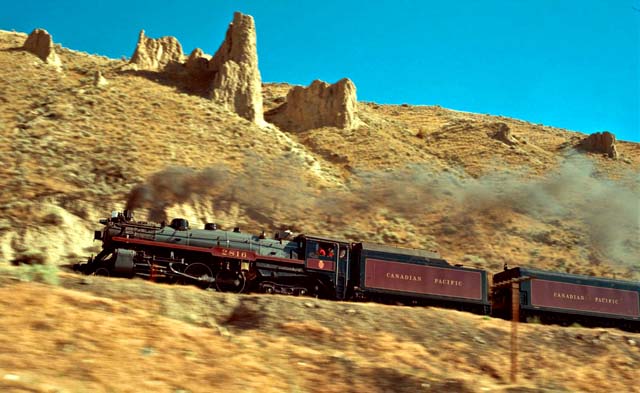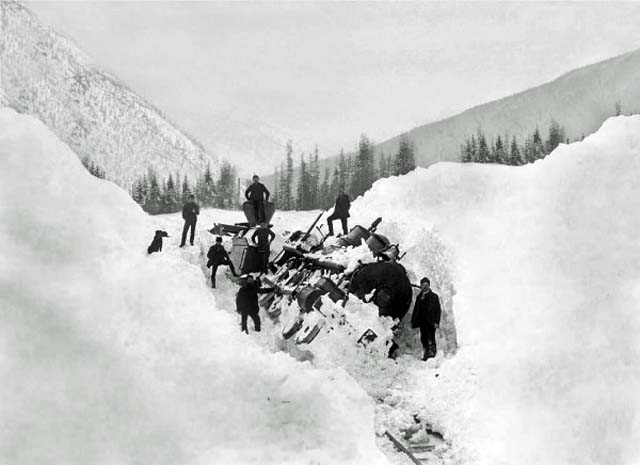
2011
|


An image from the Stephen Low documentary "Rocky Mountain Express".
21 December 2011
How an Illinois Tycoon Built Canada's Railroads
Chicago Illinois USA - A restored steam engine roars through cliffs and valleys in "Rocky Mountain Express," the new IMAX
documentary at the Chicago Museum of Science and Industry (through 15 Mar 2011) that traces the arduous process of building of the Canadian Pacific Railroad in
the 1880s, when that nation was still sparsely populated and finding its footing. (Editor's Note: That's Canadian Pacific RAILWAY dagnabit.)
"Trains have been a passion of mine," director Stephen Low said when we spoke last week. "I used to work for the Canadian Pacific Railroad a
long time ago when I was in school, I was a brakeman, a trainman, carman, a switchman."
Later, when he began making films (his resume includes documentaries about air travel and sea travel, including a film about the Titanic), he attempted a
project about Canada's transcontinental railroad. "They were building some new tunnels through the mountains and I was fascinated by the story. That fell
through for a lot of different reasons, which actually worked out because later on I got involved with IMAX, which is sort of the ultimate for a documentary
filmmaker."
Low's film doesn't quite delve into the historical nooks and crannies as much as one might hope, particularly if your appetite for this sort of thing has been
stoked by the similarly themed "Hell on Wheels," the television series that began last month on AMC. Set in 1865, "Hell on Wheels" tracks
the construction of the first transcontinental railroad in the U.S., along with the chaffing that existed within the work crews themselves as well as the
various greed-related shenanigans by those in charge. (The next new episode airs 1 Jan 2012.)
"Rocky Mountain Express" works in a different key altogether, though it does touch a bit on William Van Horne, the charismatic railroad tycoon who
all but willed the CPR into existence. Van Horne was an Illinois guy who got his start in railroading as a teen, eventually landing the top job managing
several railroads in the Midwest, including the railroad in Chicago.
In 1881, he was hired to oversee the building of the Canadian Pacific. The contract required the project be completed in ten years, Van Horne did it in five.
"In one season he laid 500 miles of track, which by modern standards is insane," said Low. "We can't do anything nowadays without fighting over
it for 20 years."
Van Horne may not be a household name in the states, but that's a different story in Canada. "We grew up with this sense that Van Horne was the father of
Canada," said Low, who is based in Montreal. "He's the greatest figure in Canadian history, or the most famous, and ironically he's an American guy
from Illinois."
There isn't much on the web about Van Horne, his Wikipedia page is unusually short for a such a storied figure, but biographical accounts paint him as a
larger-than-life, if firmly decent businessman, who took pleasure in thwarting land speculators who hoped to profit from his railroad routes.
Alas, the film doesn't offer much insight into Van Horne's personality, nor does it provide the kind of minute details that could help bring this narrative to
life. What were the day-to-day working conditions like? What kinds of tools and technology did they use? Did informal camps sprout up with the requisite
ancillary businesses, i.e. prostitutes? And how did the crews, faced with uneven terrain and staggering, massive, mountain ranges, figure out how to engineer
this thing?
Many of these questions are left unanswered. This a film primarily about images and sounds, and the footage captured by Low, just the sheer theatricality of
the train itself, is indeed stunning. An engine chugs alongside a river, a heavy plume of steam drifting back, and the picture is mirrored perfectly in the
watery reflection just below. It's a gorgeous, poetic, tableaux. Later, the train pulls into a station, steam shooting from valves, huffing like a horse
expelling air through it's nostrils.
"I've done a lot of strange things over the course of my career as a filmmaker, I've been on submarines and fighter planes, but I'd say the most
fascinating thing was to ride in a steam locomotive that's going 80 miles an hour," Low said. "It's terrifying: There's fire belching in the
cab, and steam engines jump back and forth, so you're being thrashed around in the cab. You get the feeling that you're riding a dragon. It's hot and it's
loud, but it's also exhilarating."
Logistically, the complicated shoot took five years to complete. It wasn't cheap, either. "IMAX film stock costs $5,000 for three minutes, and a
helicopter shoot can cost a quarter-million bucks, and we did that five times. So this film cost considerably more than $6 million." Low and his crew were
able to take only a few trips a year to film the train en route from Vancouver to Calgary.
Low also includes some terrific archival photos, including one of a steam engine caught in mounds of snow after an avalanche, which remains a problem for
sections of the route. "They are still a nightmare. In fact last year they had to close a portion of the railroad because the snow falls increasingly in
the mountains now because of climate change." The trains that operate today primarily haul freight, which keeps the railroad exceedingly busy.

A steam locomotive buried by an avalanche in Rogers Pass, British Columbia. Possibly the avalanche of 4 Mar 1910 in which
a large number of men working in a snow-cut were buried by the slide off Avalanche Mountain. The only survivor was Bill LaChance who was thrown from his
locomotive cab by the force of the avalanche - Date/Photographer unknown.
The film doesn't include anecdotes about how dangerous railroading still is through Canada's mountainous regions, but Low shared a few when we talked,
including this corker, relayed to him by a worker on a freight train: "Something went wrong with the brakes and the train got away from these guys,
started down the hill, and it just ran away. There was nothing they could do, there's a 20,000 ton train behind you and there's no stopping, so they just hung
on, going 90 miles an hour, whipping around these tight corners.
"The guys at the rear were able to disconnect the caboose and put on the hand break, so they were able to slow down. And miraculously, the four engines
(where the remaining crew was situated) stayed on the track. But the cars? Those went flying into the canyon and into a river. Something like 50 train cars
went into the drink. Amazingly everyone survived."
"Rocky Mountain Express" screens daily at the Museum of Science & Industry's Omnimax at 10 a.m., 12 p.m., and 2 p.m. For more info go to
msiChicago.org.
Nina Metz.

|


